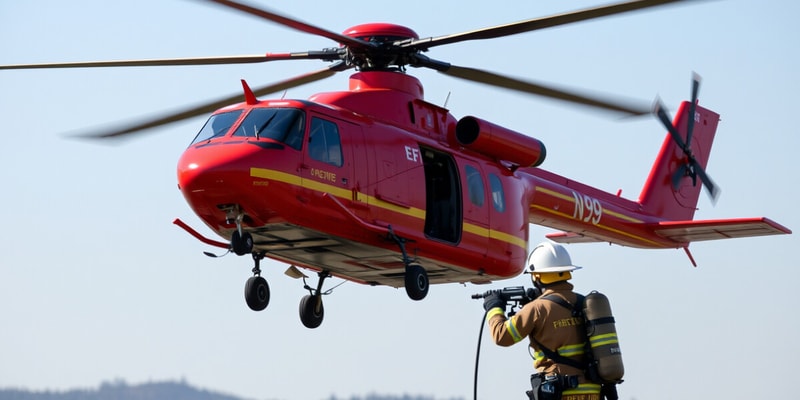Podcast
Questions and Answers
What is a primary reason for layering resources in firefighting operations?
What is a primary reason for layering resources in firefighting operations?
Which factor is considered significant in managing air levels during firefighting?
Which factor is considered significant in managing air levels during firefighting?
What is the role of the strategic level in firefighting incidents?
What is the role of the strategic level in firefighting incidents?
How does a pessimistic approach to crew assignment benefit firefighting operations?
How does a pessimistic approach to crew assignment benefit firefighting operations?
Signup and view all the answers
Which of the following best describes the responsibilities of a sector officer during an incident?
Which of the following best describes the responsibilities of a sector officer during an incident?
Signup and view all the answers
What is the primary responsibility of the Incident Commander in the hazard zone?
What is the primary responsibility of the Incident Commander in the hazard zone?
Signup and view all the answers
What percentage of air supply must firefighters have reserved when exiting the hazard zone?
What percentage of air supply must firefighters have reserved when exiting the hazard zone?
Signup and view all the answers
What should be done if crews cannot complete their tasks with the required air supply?
What should be done if crews cannot complete their tasks with the required air supply?
Signup and view all the answers
What is the policy regarding low air alarms in the Regional Operations Consistency Committee?
What is the policy regarding low air alarms in the Regional Operations Consistency Committee?
Signup and view all the answers
How should air management be approached in relation to member accountability in the hazard zone?
How should air management be approached in relation to member accountability in the hazard zone?
Signup and view all the answers
What is a key action that sector officers must take regarding crew welfare?
What is a key action that sector officers must take regarding crew welfare?
Signup and view all the answers
What is a consequence of failing to forecast resources pessimistically for tactical objectives?
What is a consequence of failing to forecast resources pessimistically for tactical objectives?
Signup and view all the answers
Who is ultimately responsible for their own welfare among firefighters?
Who is ultimately responsible for their own welfare among firefighters?
Signup and view all the answers
Study Notes
Incident Command and Air Management
- The Incident Commander is responsible for the safety and welfare of all firefighters in the hazard zone.
- Air management is a critical operating procedure for firefighter survival, continuing until the hazard is eliminated or all firefighters safely exit.
Ongoing Assessment and Strategy
- Continuous evaluation of the incident is vital using the standard hazard zone decision-making model.
- Operating in an offensive strategy is the most dangerous position, necessitating air management as a key factor in decision-making.
Air Supply Requirements
- Firefighters must exit the hazard zone with at least 33% of their air supply intact.
- If crews cannot complete tasks with sufficient air, the Incident Commander must ensure adequate replacement companies or shift to a defensive strategy.
Accountability and Management
- Air management runs parallel to the accountability of all personnel in the hazard zone, managed through command structure positions.
- Early sectorization of incidents facilitates better firefighter welfare management.
Sector and Company Officer Responsibilities
- Sector officers are tasked with managing tactical benchmarks and crew welfare within their respective sectors.
- Company Officers oversee the welfare of their specific crews and must ensure their team's safety.
ROCC Air Management Policy
- Leaving the hazard zone with low air alarms is deemed unacceptable during routine operations.
- Firefighters must exit without depleting their emergency reserve air supply.
Resource Management and Replacement
- Command and sector officers must pessimistically forecast resources necessary to achieve tactical objectives.
- Crews are less inclined to vacate operational positions if no replacements are available, maintaining operational effectiveness.
Time Management in Operations
- Time significantly influences fire involvement and air management for crews in the hazard zone.
- Sector officers manage operating times within their sectors, while strategic levels oversee the entire incident's elapsed time and its implications.
Studying That Suits You
Use AI to generate personalized quizzes and flashcards to suit your learning preferences.
Description
This quiz focuses on the strategic level of air management in firefighting. It highlights the critical role of the Incident Commander in ensuring the safety and welfare of firefighters operating in hazard zones. Understanding these procedures is essential for enhancing firefighter survival and operational effectiveness.




